

A second-generation salt wall or stock flanking the mother diapir.
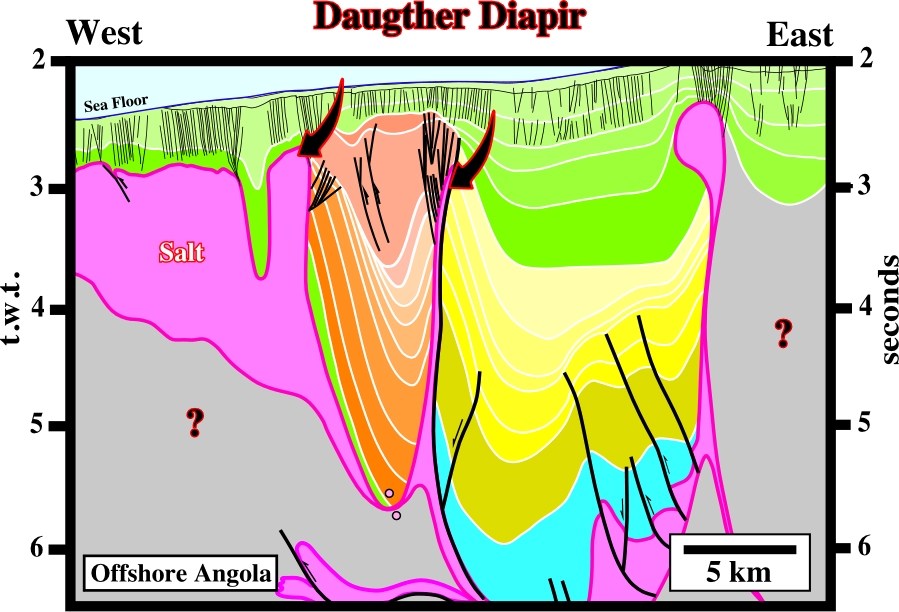
Daughter diapirs are frequent in deepwater of Angola where allochthonous salt seems to be emplaced in association with a compressional tectonic regime created as a counterpart of an extensional tectonic regime developed up-dip.
See Dynamic bulge.
A soft or incompetent layer that allows deformation of the overlying strata to be decoupled from underlying rocks, leading to independent deformation above an below the décollement.

A major tectonic disharmony is always associated with a décollement. It was the recognition of such a tectonic disharmony that allow geologists working in Angola, in the 60s, to advance the hypothesis that the disharmony was associated with an evacuated salt horizon, that is to say, a salt weld. On this seismic line, it is obvious the sediments above the disharmony are quite deformed, while those located below are undeformed (the small undulation observed below the disharmony are pull-ups and pull-downs induce by the salt structures).
Dejective Fold Style (Stille, H., 1917)
Tectonic fold style recognized in the overburden of the Permian Zechstein salt characterized by narrow synforms and broad, flat-topped antiforms.
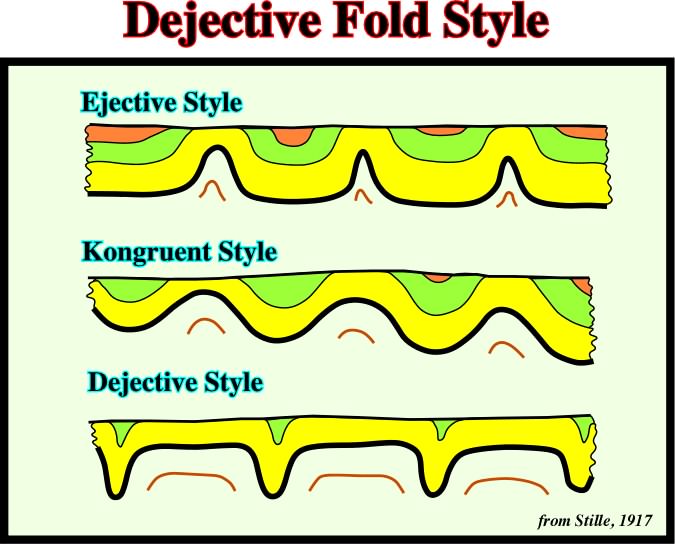
Stille, in 1917, identified three major geometries of folds decoupling over Permian Zechstein salt: (i) Ejective, characterized by narrow antiforms and broad, flat-bottomed synforms, (ii) Kongruent, characterized by an intermediate geometry between the two end-members, and (iii) Dejective, characterized by narrow synforms and broad, flat-topped antiforms.
Delta Front (Bates, R. L. and Jackson, J. A., 1980)
A narrow zone where deposition, in deltas, is most active, consisting of a continuous sheet of sand, and occurring at the effective depth of wave erosion (10m or less).
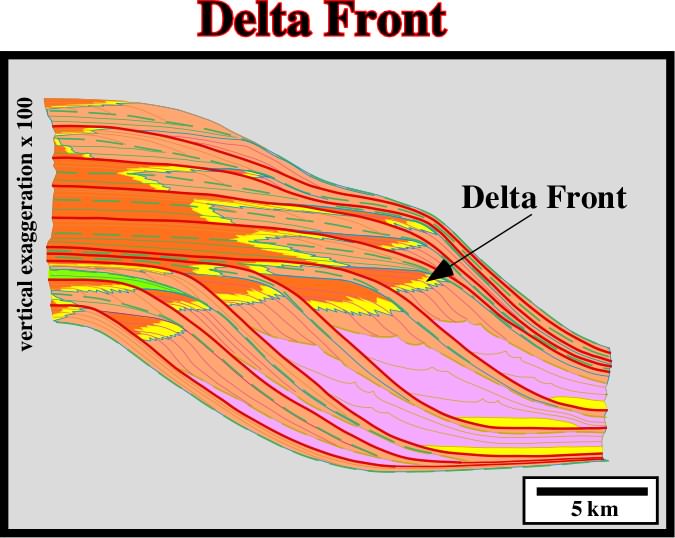
The delta front corresponds roughly to the depositional coast break, which separates the prodelta from the delta plain. As illustrated, the delta front can develop in lowstand as well as in highstand geological situations. Following relative sea level changes, the delta front can prograde or retrogradate.
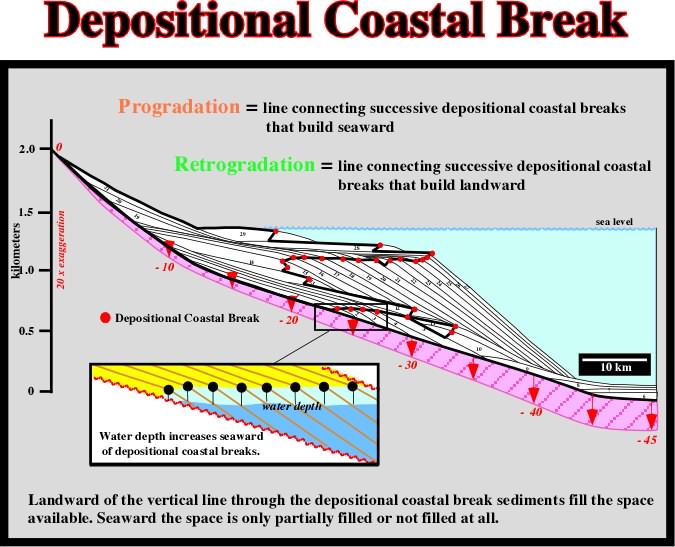
The picking of depositional coastal breaks, roughly the landward limit of the delta front, allows to individualize transgressive (backstepping) from regressive episodes, which are characterized by a forestepping geometry. On the other hand, as the water depth in the delta front is almost zero, the loci of the successive depositional coastal breaks allow to determine the water depth seaward of the coastal break.
A geographical restricted complex area, where deltaic sediments accumulates, described in geomorphologic terms and characterized by physical, chemical, lithological and biological conditions pertaining to or associated with a delta.
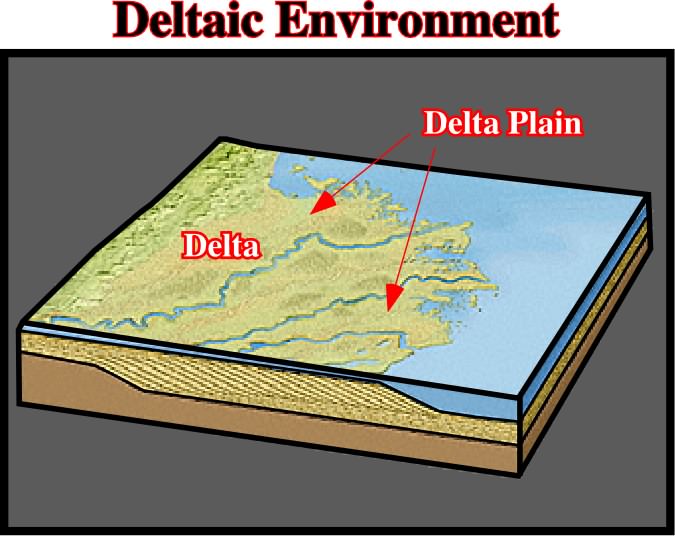
Deltas characterize deltaic environments. Deltas are low, nearly flat, alluvial tract of land at or near the mouth of a river, commonly forming a triangular or fan-shaped plain of considerable area, crossed by many distributaries of the main river, perhaps extending beyond the general trend of the coast, and resulting from the accumulation of sediment supplied by the river in such quantities that it is not removed by tides, waves and currents. Most deltas are partly sub-aerial and partially below water.
A superposition of a denser layer above a less dense layer. In a salt basin, there is always a density inversion below the inversion point, since the density of the salt, which cannot be compacted, is lower than the density of the sediments.
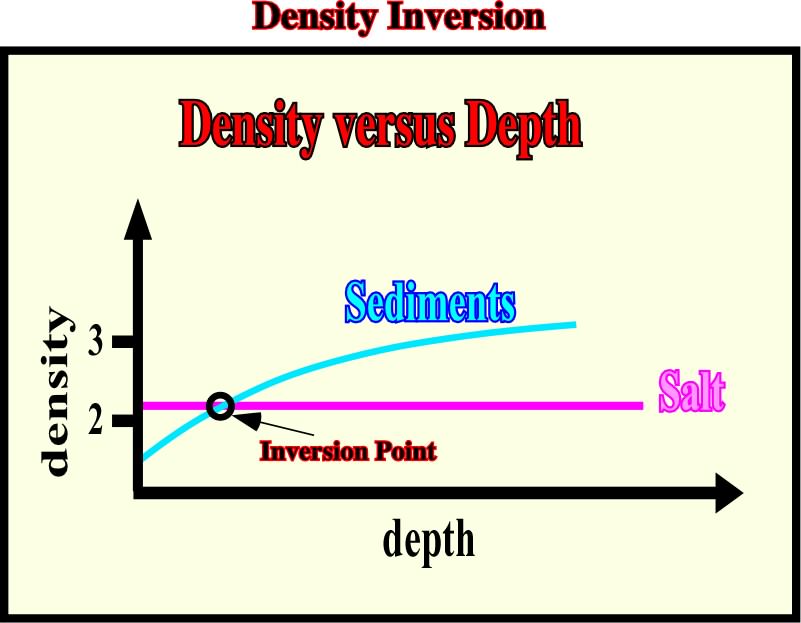
Above the inversion point, the pressure of the sediments against the salt does not balance the pressure that salt exert against the sediments. Contrariwise, below the inversion point, as the density of sediments is higher than the density of the salt, the pressure of the sediments against the salt is much higher than the pressure of the salt against the sediments.
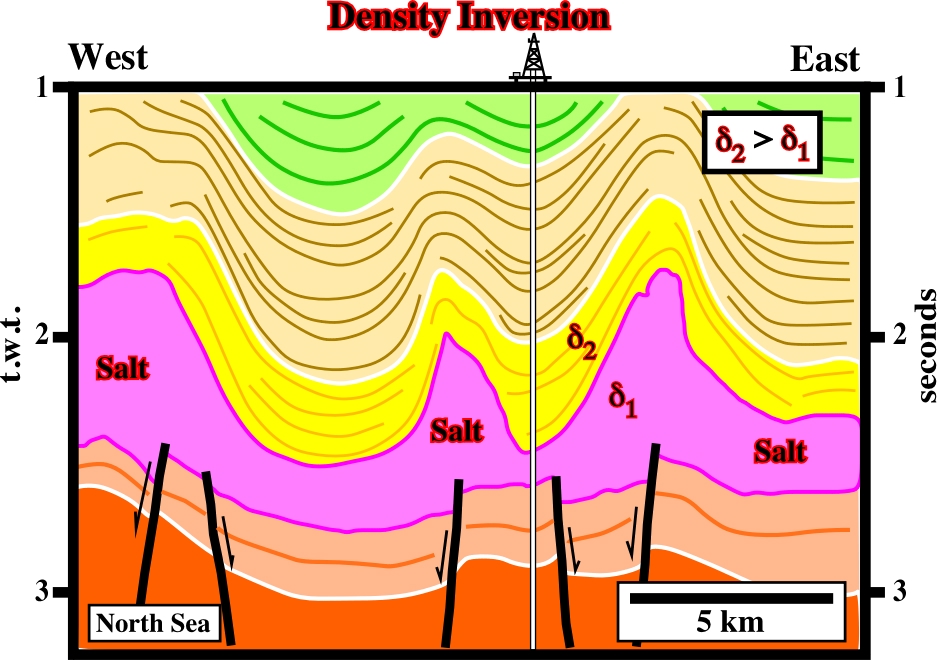
The Cretaceous shortening that took place in southern North Sea, mask the effects of the density contrast between the salt and the overburden. Indeed, at a certain depth, the density of the salt is lower than the density of the overburden, so, one can say that there is a density inversion.
Ranges between 2.15 and 2.17 depending of the composition.
An area or site of maximum deposition. The thickest part of any specified stratigraphic unit in a depositional basin.
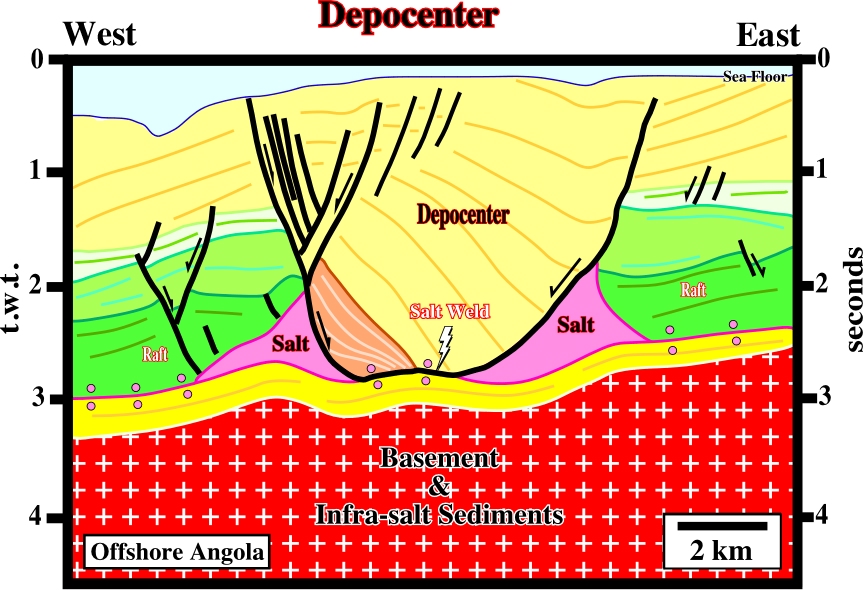
The internal configuration of the stratigraphic interval filling the depocenter located in the middle of this line suggests the associated compensatory subsidence was created by an almost complete down-dip evacuation of salt of the salt dome. Two relict structures are easily recognized up-dip and down-dip of the depocenter. At the bottom of the depocenter, the green interval has an internal configuration showing an inward thickening, which suggests that it was deposited in a small pod on the top of the pristine salt dome. Primary salt welds are recognized at the bottom of the depocenter and in left and right ends of the line.
A salt expulsion basin subsiding into salt masses in shallow water, typically containing deltaic deposit, the sandiest parts of which drape over or against the flanking salt diapirs.
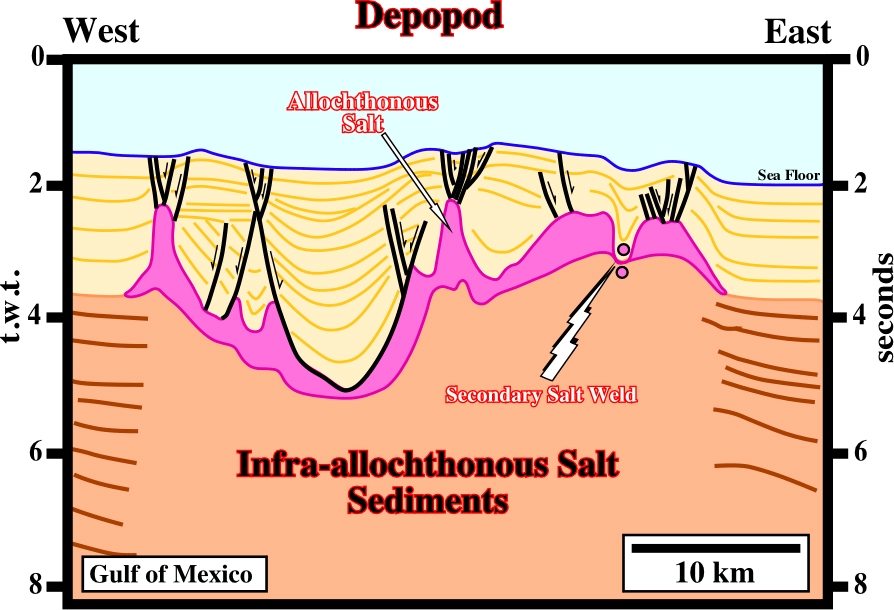
If the deepest parts of the mini-basins, recognized on this seismic line, were filled by deltaic sediments, then, at the time of the filling, the salt structures could be considered as depopod. Then, it is quite sure they evolved into typical mini-basins (or salt expulsion basins), which were progressively filled by deepwater sediments as they buried.
See: Shelf Break.
The amount of sediment accumulated in an aquatic environment over a given period of time, usually expressed as thickness of accumulation per unit of time. Depositional rate is a synonym of rate of sedimentation. However, as suggested by Sadler (1981), one should never forget stratigraphic sections are local archives of the geologic history. The records of these archives are the sedimentary beds deposited, in sequence, and which are, mostly, numbered according to their thickness rather than their time of deposition. Briefly speaking, depositional rates must take into account the completeness and preservation of stratigraphic sections.
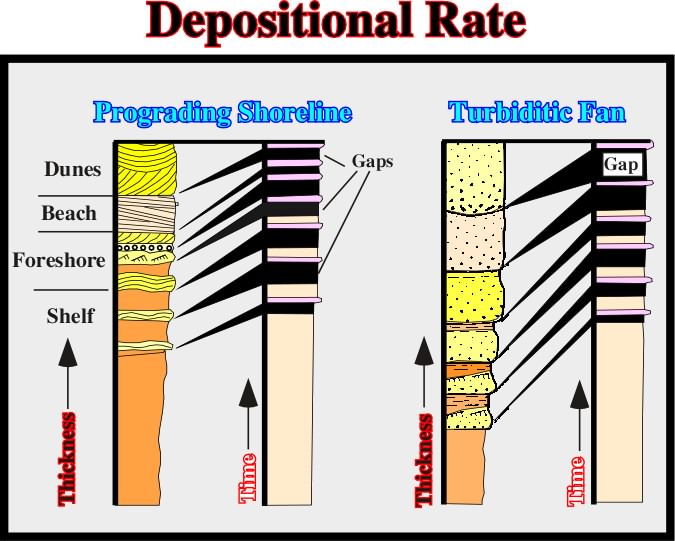
In these two stratigraphic models, it is important to notice that in the upper part of both sections, the time-duration of the periods of non-deposition is greater than the deposition time-duration. Indeed, most of the geologic events, which took place during deposition periods were not preserved. Therefore, the completeness (effective deposition time versus the total time of stratigraphic section), and preservation of stratigraphic sections must be taken into account when assessing depositional rates.
Depositional Sedimentation Level
Roughly to the effective depth of wave erosion (10m or less), particularly in shallow water deposition.
A salt expulsion basin subsiding into or between thick salt masses in deep water, typically containing mass-flow or turbiditic deposits, whose sandiest part lie in unplapping configuration in the center of the depotrough. Synonym of depocenter in salt expulsion basins.
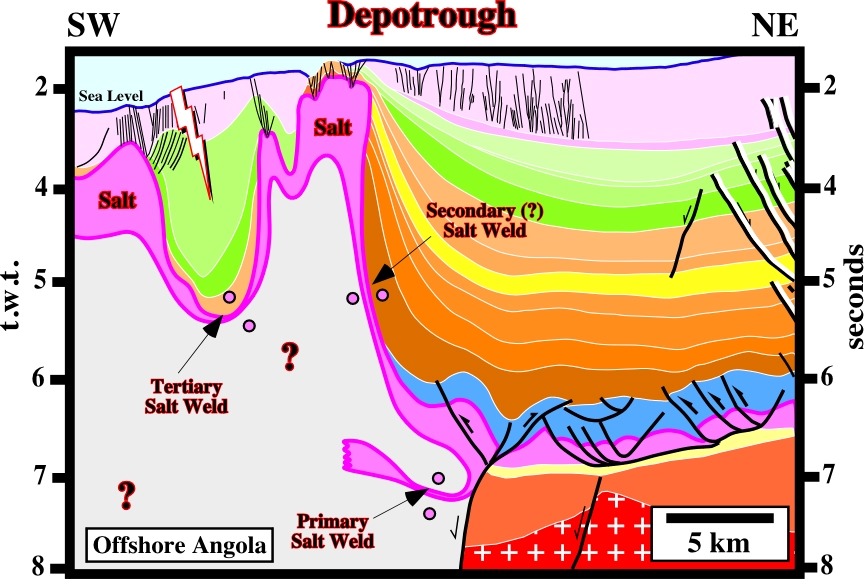
Taking into account the water depth, it is quite evident, on this line, the depocenter, created by salt evacuation within the allochthonous salt sheet, can be considered as a depotrough.The sediments filling the depocenter were likely deposited in deepwater and probably associated with turbidite deposits.
Pluglike salt diapir with sub-circular planform detached from the mother salt layer.
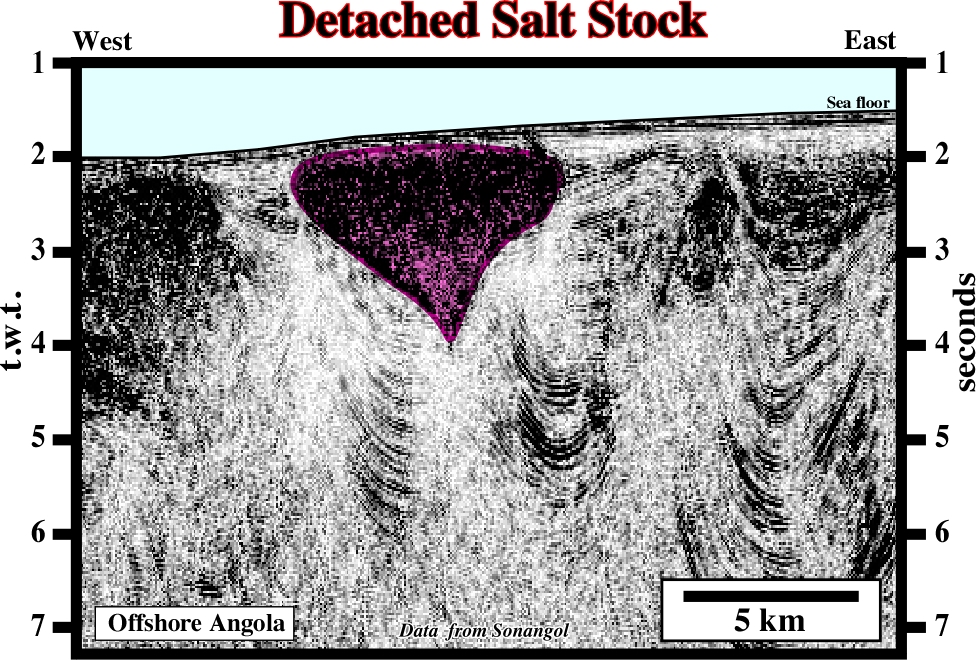
Detached salt structures are also known as drop structures ("gouttes" in French). They are separated from the mother rock by a secondary salt weld, which can be predicted, and sometimes picked, using the geometry of the reflectors underlain the detached structure.
Directed stresses acting in particular directions. This causes the alignment of minerals, giving rocks their foliation. Depending on the direction of the stresses, different structures and/or textures may develop.
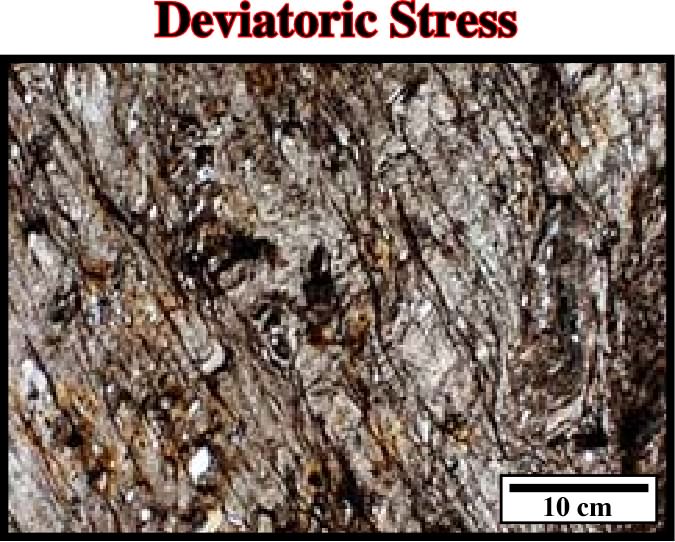
The foliation recognized in majority of the metamorphic rocks, as illustrated above, is induced by deviatoric stresses.
Devonian Salt Deposits (Zharkov, M. A., 1984)
Devonian salt-bearing deposits are known at present from the following basins: North Siberian, Tuva, Chu-Sarysu, Morosovo, East European Upper Devonian, West Canadian, Michigan, Hudson, Bonapart Gulf, and Adavale Basins. Besides, DEvonian evaporites represented by gypsum and anhydrite were observed also in Chulym-Yenisei, Minusinsk, Kuenetsk, Teniz, Turgai, Ili, Moesian-Wallachian, Canadian Artic Archipelago, Moose River, Illinois, Central Iowa, Tindouf, Canning, Ackaringa, Carnavon and Bancannia Basins.
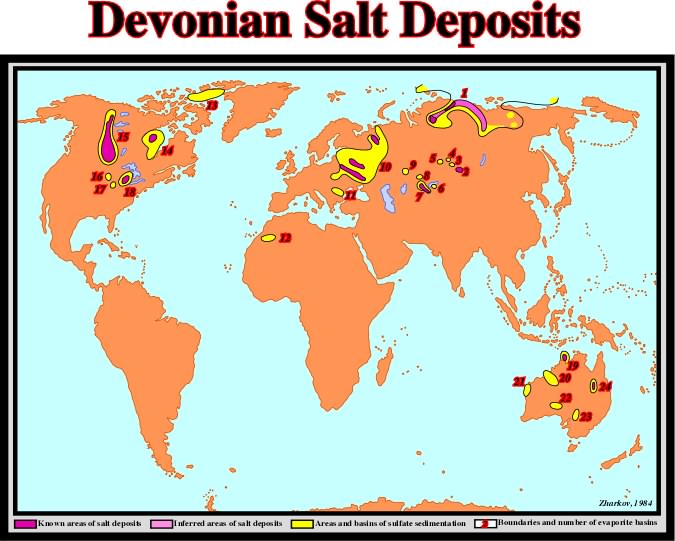
The distribution of Devonian evaporites illustrated above is as following: (1) North Siberian, (2) Tuva, (3) Minusinsk, (4) Chulym-Yenisei, (5) Ili, (6) Chu-Sarysu, (8) Teniz, (9) Turgai, (10) Morsovo and East European Upper Devonian, (11) Moesian-Wallachian, (12) Tondouf, (13) Canadian Arctic Archipelago, (14) Hudson, (15) West Canadian, (16) Central Iowa, (17) Illinois, (18) Michigan, (19) Bonaparte Gulf, (20) Canning, (21) Carnavon, (22) Arckaringa, (23) Bancannia, (24) Adavale.
Mass of salt that has flowed in a ductile manner to discordantly pierce or intrude its overburden.
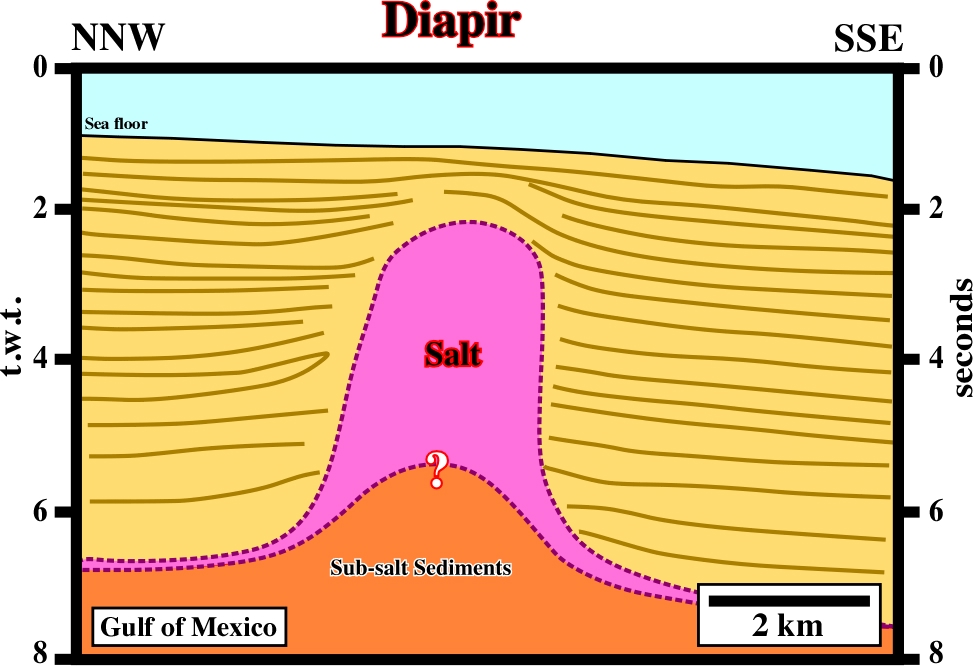
This diapir, located in Gulf of Mexico, still is attached to the mother salt layer. In depth, the bottom of the diapir is roughly flat. However, on this seismic line, that is to say, on a time profile, the proposed bottom of the structure is speculative. There is any marker associated with it and it is quite difficult to calculate the pull-up induced by the thickness of the diapir.
Diapiric Fold (Ruig, M. J., 1995)
The expression used by several authors, in Eastern Prebetic Foldbelt, in reference to folds in the overburden that are supposedly cored by Triassic evaporites. These folds are thought to have been forced by the active diapiric rise of evaporites. However, when they formed, no clear density inversion existed between the Triassic evaporites and their carbonate cover, which precludes uplift of large blocks of the overburden. It seems these folds were formed by buckling, under lateral compression, rather than by vertical diapiric motion.
See diapiric fold.
General term expressing different processes of piercing or rupturing of domed or uplifted rocks by mobile core material.
Creation of lateral pressure gradients on salt caused by surface slope or lateral variations in thickness, density, or strength of the overburden. Such variations may be sedimentary or structural. Unlike the buoyancy mechanism, differential loading requires no density inversion or burial of salt below the level of neutral buoyancy to operate; it is thus an effective initiator of halokinesis and is especially effective near surface.
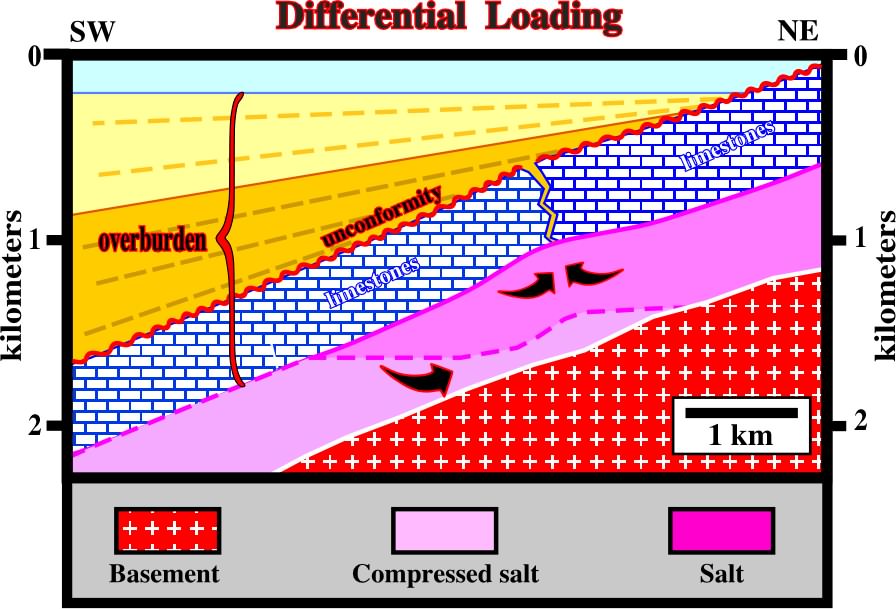
The progressive seaward thickening of the overburden, mainly due to thickening of the post-unconformity sediments, creates a differential pressure on the salt layer that, when big enough to overcome the friction strength, obliges the salt to flow.
An intracrystalline plastic flow involving a combination of glide and climb of dislocations through the crystal lattice to change grain shape. At low temperatures, grain boundaries and inclusions can obstruct gliding, resulting in dislocation tangles and work hardening. At higher temperatures, recovery takes place by cross-slip and climb past obstacles; this annihilates dislocation tangles or orders them into dislocation walls by polygonization. Dislocation creep is dominant at high deviatoric stresses and high strain rates.
Salt, as other rocks, can be dissolve whether, at bottom of the sea, by seawater or, in depth, by an aquifer. Salt dissolution can create complex structures in the overburden that are often difficult to interpret as illustrated below.
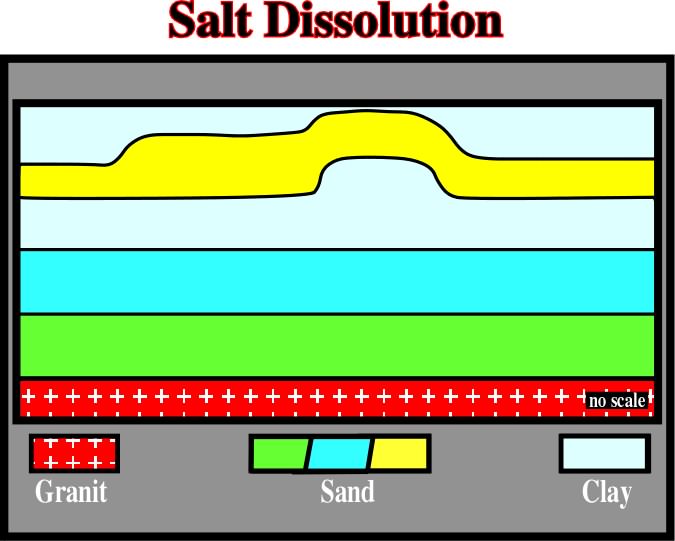
In North Sea, particular structures, as those illustrated above, can be recognized on seismic lines. Such structures cannot be explained by the conventional tectonic regimes. Salt dissolution is often the more likely solution.
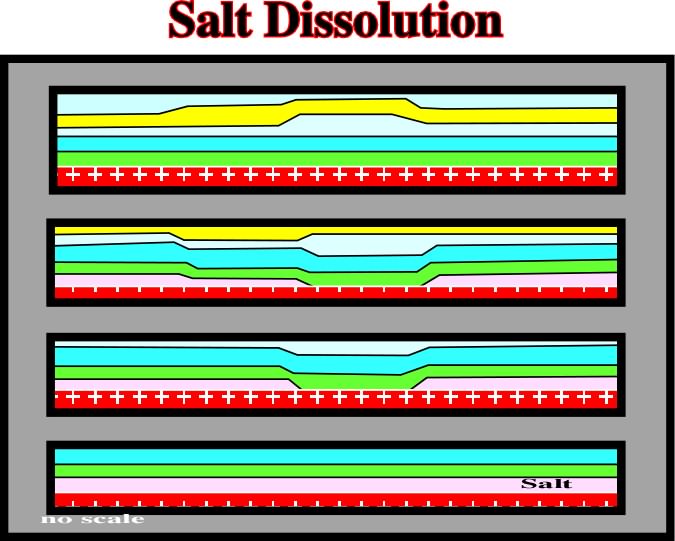
The structures illustrated on previous figures were explained by Shell's geologists invoking a complete dissolution of an autochthonous salt layer, as illustrated above.
A common rock-forming rhombohedral mineral: CaMg(CO3)2. Part of the magnesium may be replaced by ferrous iron and less frequently by manganese. Dolomite is white, colorless, or tinged yellow, brown, pink, or gray. It had perfect rhombohedral cleavage and a pearly to vitreous luster, effervesces feebly in cold dilute hydrochloric acid, and forms curved, saddlelike crystals.
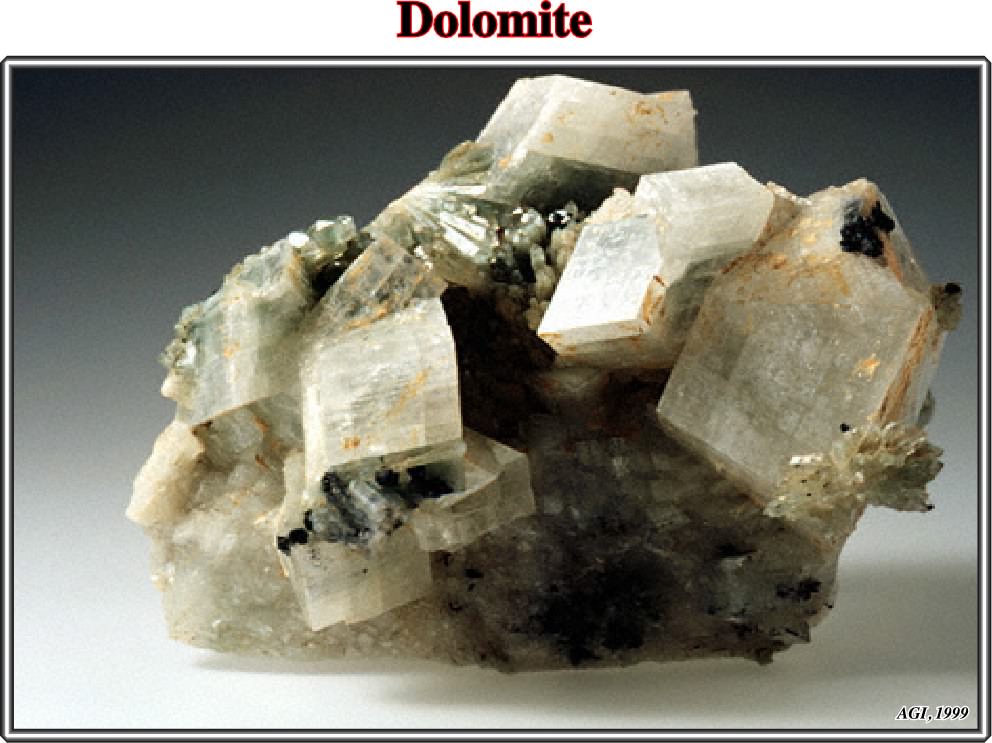
Dolomite is found in extensive beds as dolomite rocks. It is a common vein mineral, and is found in serpentinite and other magnesian rocks.
See: Diapir
A salt structure generally disconnected from the mother salt layer with thick overburden depocenters are developed around it. Depocenters developed during the mound stage are generally located outward of those associated with the dome stage: depocenters migrate toward the flanks of the dome.
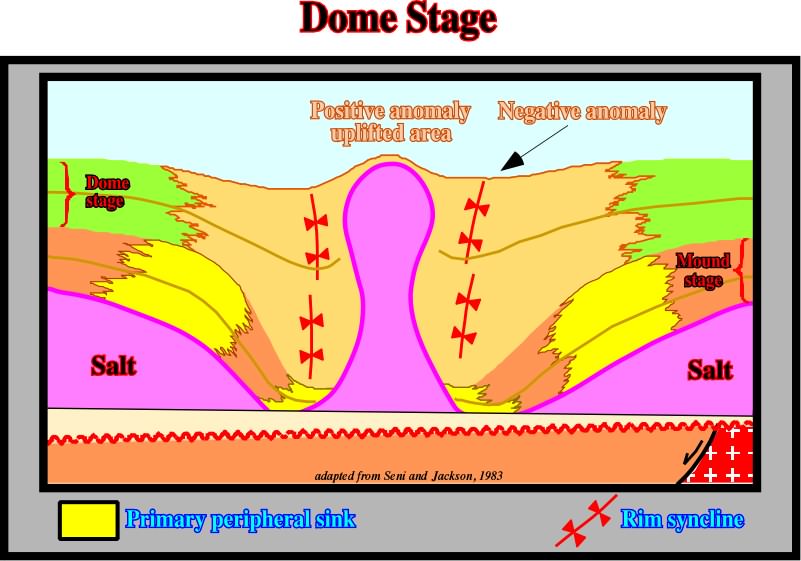
Notice the migration of the depocenters towards the flanks of the salt dome, as well as the uplifted area just above the top of the dome.
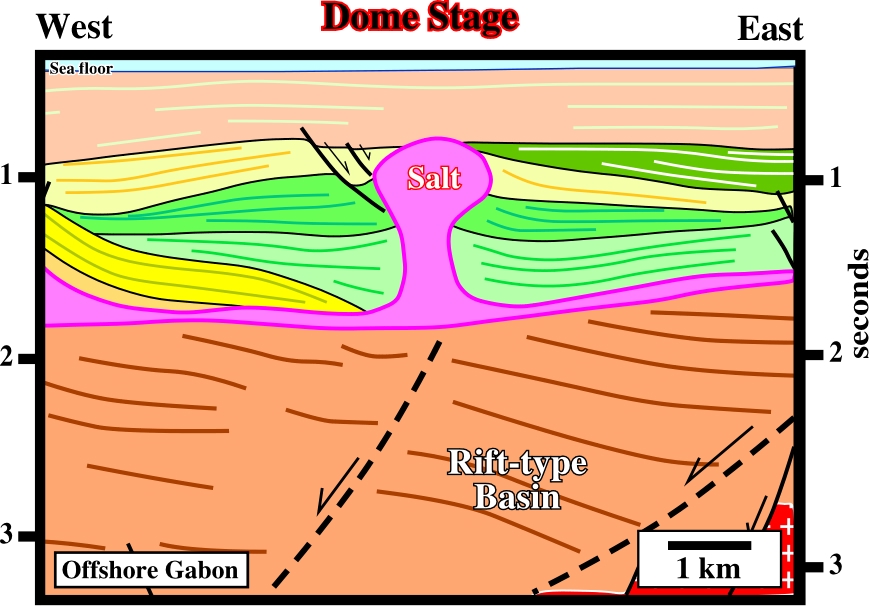
On this seismic line, as in the previous sketch, the depocenters migrate toward the flanks of the dome, which is not disconnected of the mother salt layer.
The observed periodic spacing of an instability. It may differ from the characteristic wavelength if the interface is initially deformed or if Rayleigh-Taylor instability is influenced by other effects, such as differential loading, regional strain, thermal convention, or faulting.
Syndepositional diapir growth. The structure increases relief by growing downward relative to the sedimentary surface. Its base subsides together with surrounding strata as the basin fills with sediment, while its crest remains at or near the surface.

This downbuilding tectonic evolution was proposed as a likely explanation of the Green Knoll structure, in Gulf of Mexico, which is illustrated on the seismic line below.
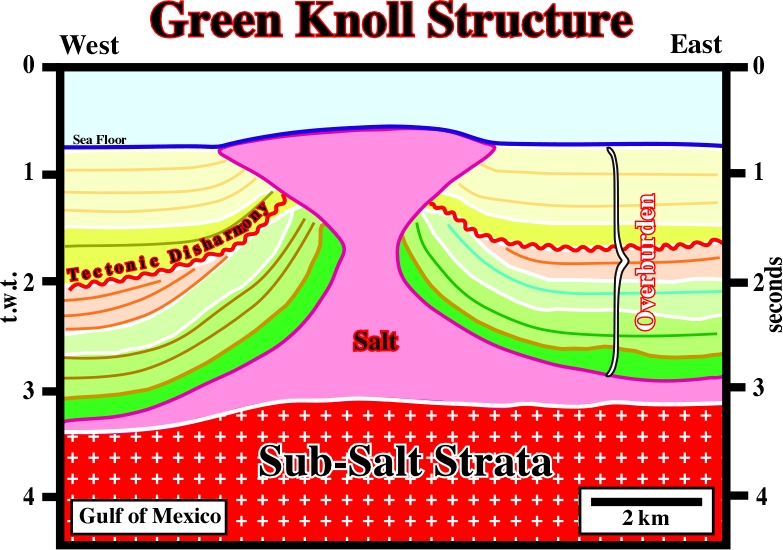
This structure (Green Knoll) is explained by certain explorationists as a consequence of a downbuilding evolution associated with passive diapir and contraction. Its hydrocarbon potential was tested recently, but the result, as suggested by the proposed evolution (see previous figure), were more than disappointing.
Basal geometrical relationship in which initially inclined strata terminate down-dip against an initially horizontal or less inclined surface.
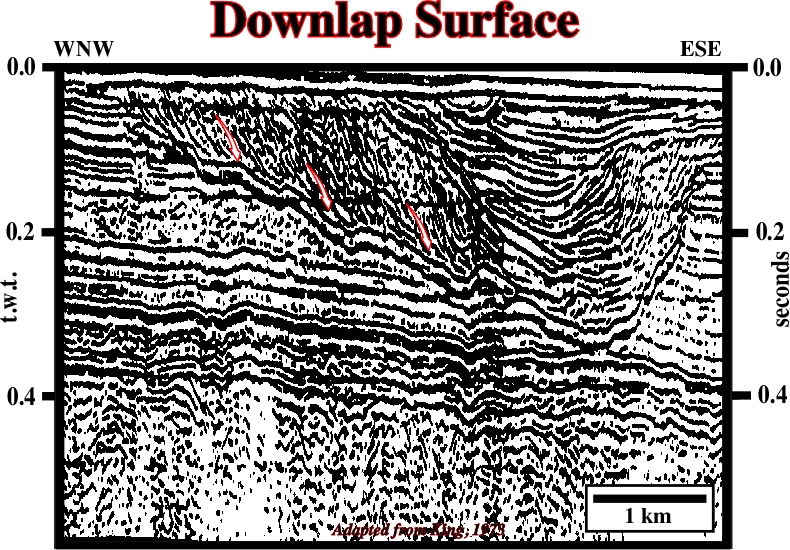
Downlap surfaces, as the one illustrated above (bottom of a point bar), are at the base of progradational or regressive interval. Seismic downlap is a downlap interpreted from a seismic section. It is a relation in which seismic reflection interpreted as initially inclined strata terminate down-dip against a reflection discontinuity interpreted as an initially inclined or horizontal unconformity. Apparent downlap on seismic section may occur where reflections are representing units of inclined or tangential strata terminate down-dip, but the strata themselves actually flatten and continue as units which are so thin that they fall below the resolution of the seismic tool.
Synonym of hangingwall (see: hangingwall).
Decoupling above and below evaporites. In certain salt basins and particularly in Iran, the Miocene salt decoupled upper cover from lower cover in such way that salt flow into the overlying anticline and underling synclines. This segregation formed salt bulges (looking upward and downward) laterally separated by much thinner salt.
Zone of bending strata on either side of a fault or salt flanks. Drag may occur because a fault surface or salt flanks are curved or as a manifestation of the resistance to slip.
Synonym of detached salt stock.
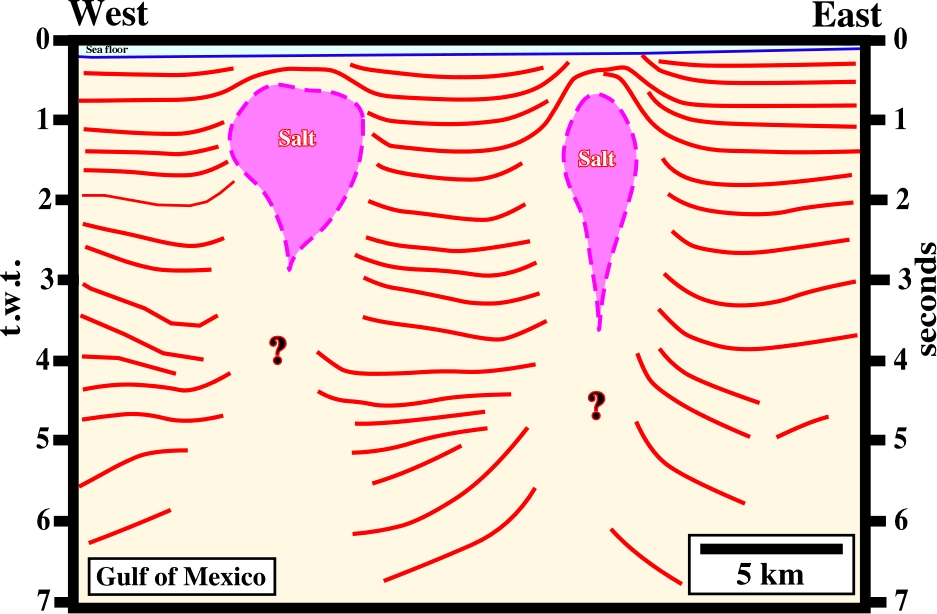
On this seismic line, it is quite difficult to see whether the drop structures are associated with an allochthonous salt nappe or to a deeper autochthonous salt layer. Indeed, two obvious tectonic disharmonies are recognized; one at 4.2 seconds and another at 6.0 seconds. Certain explorationists attach the eastern structure to the mother salt layer (autochthonous salt), while the western structure is attached to an allochthonous salt layer, which is just underlined by a secondary salt weld.
A tabular igneous intrusion that cuts across the bedding or foliation of the country rocks. In salt tectonics few geologists erroneously use the term salt dyke as synonym of salt sill.
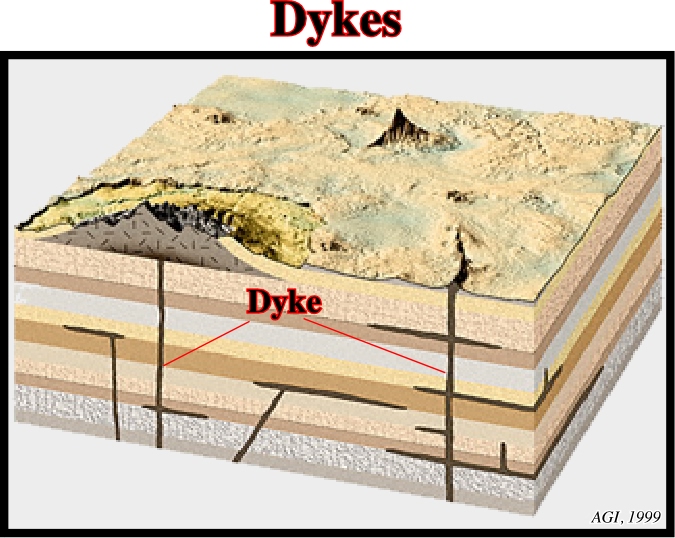
Dyke sets, that is to say, groups of linear or parallel dykes are often good hydrocarbon reservoirs, as it is the case in certain oil fields in Argentine.
Bulge caused by pressure of flowing fluid against its overburden, for example the viscous flow (analogous to a fountain) of salt upward from a diapir stem. Such bulges can extend above the level of neutral buoyancy, the most striking examples being the mountainous extrusive salt domes of southern Iran. Dynamic bulges can lift strata above the regional surface; this deformation is recorded by onlapping strata and erosional truncations, which may themselves be deformed later. A dynamic bulge is likely to subside after the underlying stem pinches off or the source layer is exhausted; the record of a decaying bulge is preserved as structural inversion in any synkinematic overburden.
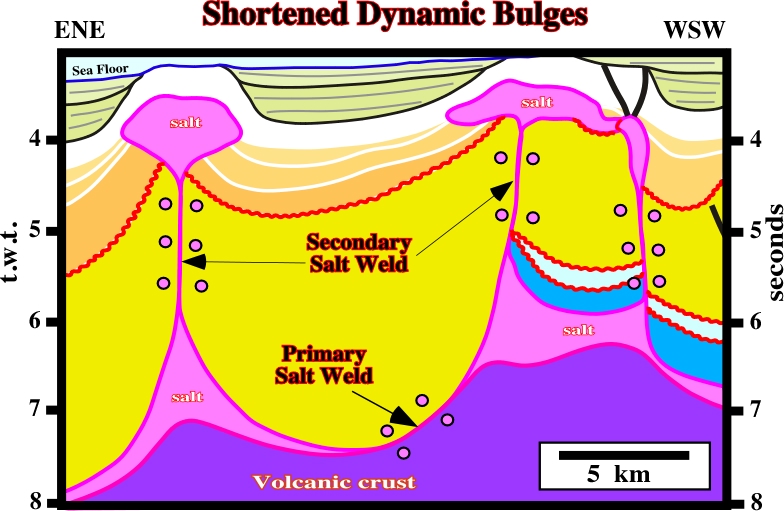
These salt structures have been interpreted as dynamic bulges shortened by a quite recent compressional tectonic regime that certain geologists associate with a significant ridge-push. The deformed onlap surfaces fossilizing the sedimentary interval overlying the bulge suggest that the ridge-push still is going on.
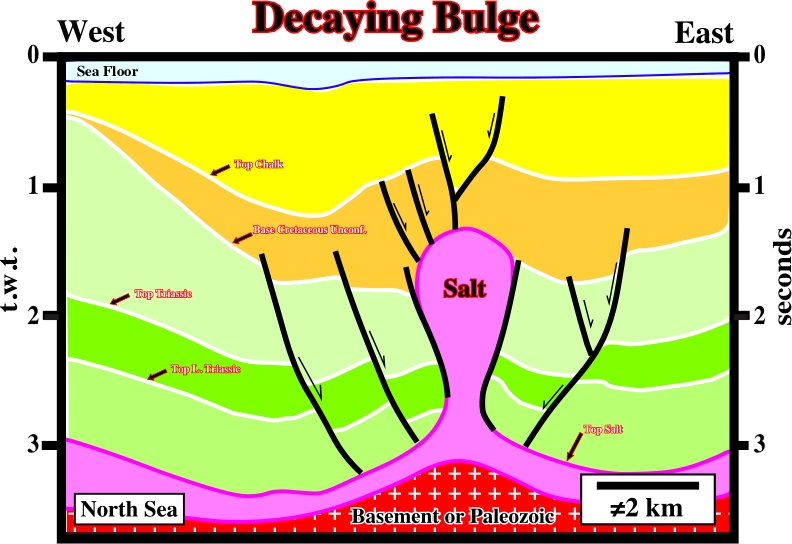
On this seismic line, it is interesting to notice that the depocenter of the brown interval (base Cretaceous / Top Chalk) is inverted, what means that during the Lower Cretaceous the salt dome collapse, locally increasing the space available to the Chalk deposits. Later, a compressional tectonic regime took place shortening the salt dome as well as the overburden, creating a nice inversion of the Chalk sediments.